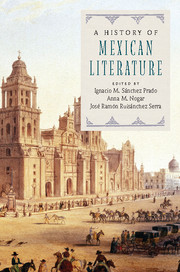Book contents
- Frontmatter
- Contents
- List of contributors
- Introduction
- PART I COLONIAL LITERATURE
- PART II THE NINETEENTH CENTURY
- PART III TWENTIETH AND TWENTY-FIRST CENTURIES
- PART IV MEXICAN LITERATURE BEYOND BOUNDARIES
- 25 The Literatures of Greater Mexico
- 26 Indigenous Literatures of México
- 27 Writing Cinema: The Communicating Vessels of Literature and Film
- 28 Popular Narratives: Telenovelas, Corridos, Historietas, and Other Literary Pursuits
- Index
- References
26 - Indigenous Literatures of México
from PART IV - MEXICAN LITERATURE BEYOND BOUNDARIES
Published online by Cambridge University Press: 05 July 2016
- Frontmatter
- Contents
- List of contributors
- Introduction
- PART I COLONIAL LITERATURE
- PART II THE NINETEENTH CENTURY
- PART III TWENTIETH AND TWENTY-FIRST CENTURIES
- PART IV MEXICAN LITERATURE BEYOND BOUNDARIES
- 25 The Literatures of Greater Mexico
- 26 Indigenous Literatures of México
- 27 Writing Cinema: The Communicating Vessels of Literature and Film
- 28 Popular Narratives: Telenovelas, Corridos, Historietas, and Other Literary Pursuits
- Index
- References
Summary
One of the twentieth century's greatest proponents of indigenous literatures of Mexico, Carlos Montemayor, once stated that the three great branches of Mexican literatures are those written in Spanish, Latin, and indigenous languages (Montemayor and Frischmann, 2004: 1). His decades-long insistence on establishing parity between indigenous language writing and Spanish and Latin drew attention to the conscious and unconscious ranking of languages and literatures in Mexico. Based on long-held, erroneous understandings of indigenous cultures and expression, the mortar holding this hierarchy together is the pernicious fallacy that the sixty-eight indigenous languages of Mexico are only “dialects” incapable of transmitting abstract and complex thought. For our part, we follow Montemayor and take as a given that indigenous cultural production requires and deserves the same kind of scholarly attention that other types of Mexican literature have long enjoyed. This is not to say, however, that indigenous literatures can or should be addressed or analyzed in exactly the same fashion as their Western counterparts. Instead, we propose an alternative frame that engages indigenous literatures of Mexico on their own terms and in their unique sociopolitical contexts. This approach (1) reaches back before the arrival – some would say imposition – of the Roman alphabet and includes pre-Hispanic practices and technologies of expressive communication; (2) views indigenous oral and textual practices (written, painted, carved, etc.) as mutually constitutive and declines to separate them into discreet categories; (3) understands indigenous literatures as those produced by indigenous people, regardless of the language with which they express themselves; and (4) resists classifying indigenous literatures according to dominant-culture literary genres. Our brief sketch of the contours of the dynamic trajectory of indigenous literatures in Mexico is aimed at marking both the presence and persistence of indigenous literatures in Mexico, a practice we understand as the creation, preservation, and transmission of knowledges.
Whereas the bulk of our discussion will focus on postconquest alphabetic writing, we emphatically insist that the production of indigenous literatures and writing (in its broadest sense) began long before the arrival of the Spaniards.
- Type
- Chapter
- Information
- A History of Mexican Literature , pp. 397 - 410Publisher: Cambridge University PressPrint publication year: 2016
References
- 1
- Cited by



